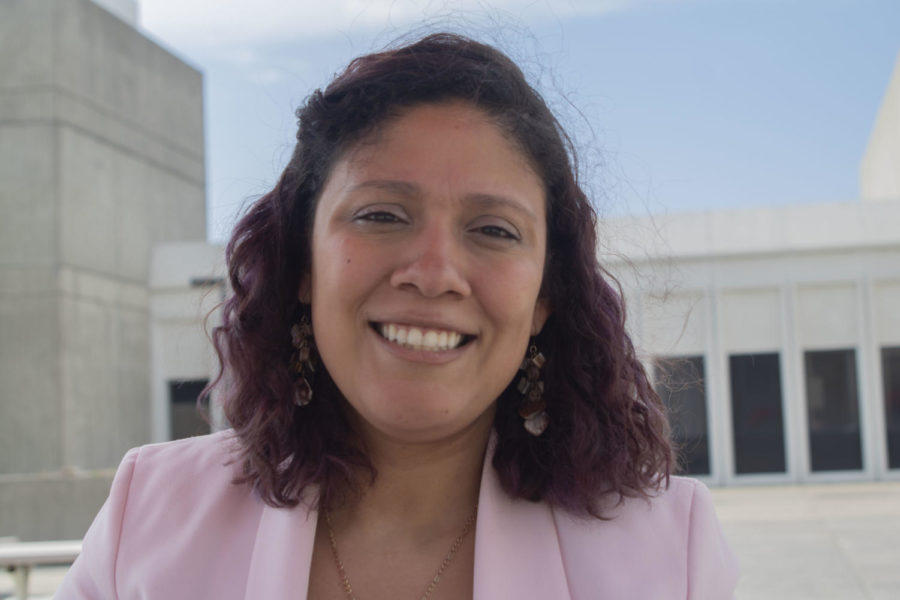Diversity issues in veterinary medicine: why do they exist and what is being done?
Jackie Norman/Iowa State Daily
Graciela Orantes, a Veterinary Medicine student.
April 2, 2018
In fall of 2017, the Iowa State College of Veterinary Medicine had a 26 to 518 minority to majority student ratio, or a 0.05 percent minority student population.
Statistics from the Iowa State University Registrar’s Office say that of the 544 students enrolled in the Vet Med college that semester, there were two American Indians or Alaskan Natives, zero African Americans, seven Asians, zero Native Hawaiians or Pacific Islanders, 15 Hispanics/Latinos and two students of two or more races.
Iowa State, and the veterinary medicine profession as a whole, have been working to increase these low percentages.
According to the Association of American Veterinary Medical Colleges’ (AAVMC) website, “contrary to societal trends, veterinary medicine remains one of the least diverse professions in the United States.”
The AAVMC has an effort called the DiVersity Matters Initiative, which is intended to increase diversity in veterinary medicine programs by conducting career fairs, presenting at key diversity meetings and conferences and working to generate interest in veterinary medicine, among other things.
According to the AAVMC website, since the 2005 launch of the DiVersity Matters Initiative, the number of racially and/or ethnically underrepresented students has increased 134 percent and now stands at 17.4 percent of total enrollment.
Despite such initiatives, the Iowa State University College of Veterinary Medicine’s diversity figures remain low.
According to Patrick Halbur, the current interim dean of the College of Veterinary Medicine, Iowa State currently ranks dead last in diversity among the other 30 veterinary medicine colleges in the nation.
“I guess it doesn’t bother me too much, but that is because I was in a predominately white undergraduate program, as well,” said Vet Med student Graciela Orantes on the lack of diversity in the vet school. “I went through my adaptation process there. I think currently I’m at a point where I accept myself for who I am without the need of others’ approval.”
But Orantes explained at times, the “imposter syndrome” still hits her hard. She explains the imposter syndrome as “where you look around and are in the minority and wonder, ‘Gosh, was it an accident that I’m here?’”
Orantes said while at school, vet students are so busy and stressed that minority does not play a large role. Outside of the classroom is where she finds it difficult to bond, possibly because the majority forgets to learn about the culture of the minority.
“Maybe it’s just because we are in a heavy and rigorous program with a limited free time environment, but it can make me feel isolated at times. Sometimes it’s easier to bond over past jobs or physical activities than over cultural identity,” Orantes said.
The recent presidential election and offensive posters found around Iowa State’s campus make Orantes wonder how her classmates really feel about her being here.
“In a way, I understand that it’s Iowa and it’s a predominantly white state,” Orantes said.
Heather Greenlee, chair of the diversity and inclusion committee for Vet Med, believes the lack of diversity in veterinary medicine is not because there are not diverse candidates out there, but because they are not educated on all the opportunities that veterinary medicine has to offer.
“One of the reasons, I feel, is that in general, the public isn’t really aware of how relevant veterinary medicine is to everyone’s lives,” Greenlee said. “It’s not just about treating animals, but it also plays a role in food security, public health and biomedical research.”
Orantes agrees the lack of educational opportunities offered contributes to the lack of diversity in veterinary medicine. She believes that if it would not have been for her academically rigorous undergraduate education, she would not be in vet school right now.
“I am the product of the Chicago Public Schools system. I would say that I am the exception and not the rule,” Orantes said. “As a poor inner city kid, I had limited resources to academically rigorous schools with up-to-date educational material. Even though I advanced to higher levels of education, my mom had to make sacrifices to even afford to attend.”
Orantes explained that by “attend,” she meant not only the cost of education, but also transportation, appropriate nutrition and uniform requirements.
“I think if [the Vet Med college] opened pathways or recruited interested students from inner cities, we could increase the diversity in the school,” Orantes said.
According to Greenlee, in an effort to increase engagement of the undergraduate population, the college will be hosting a program called vet camp where eight undergraduate students will spend the summer learning about veterinary medicine. The college has also been attending local high school career fairs to get the word out to high school students.
Additionally, Greenlee said the college is examining it’s policies to make sure that they are not inadvertently favoring one group or another in admissions.
















